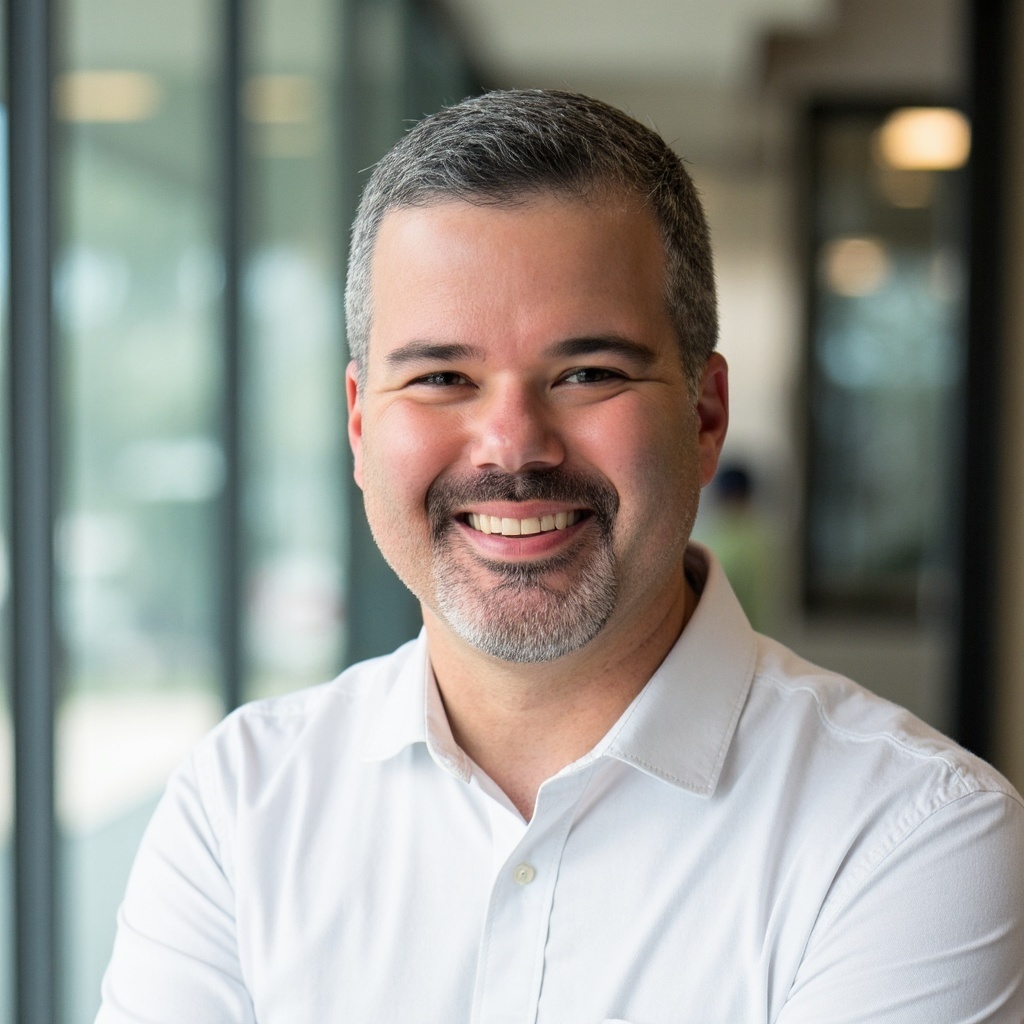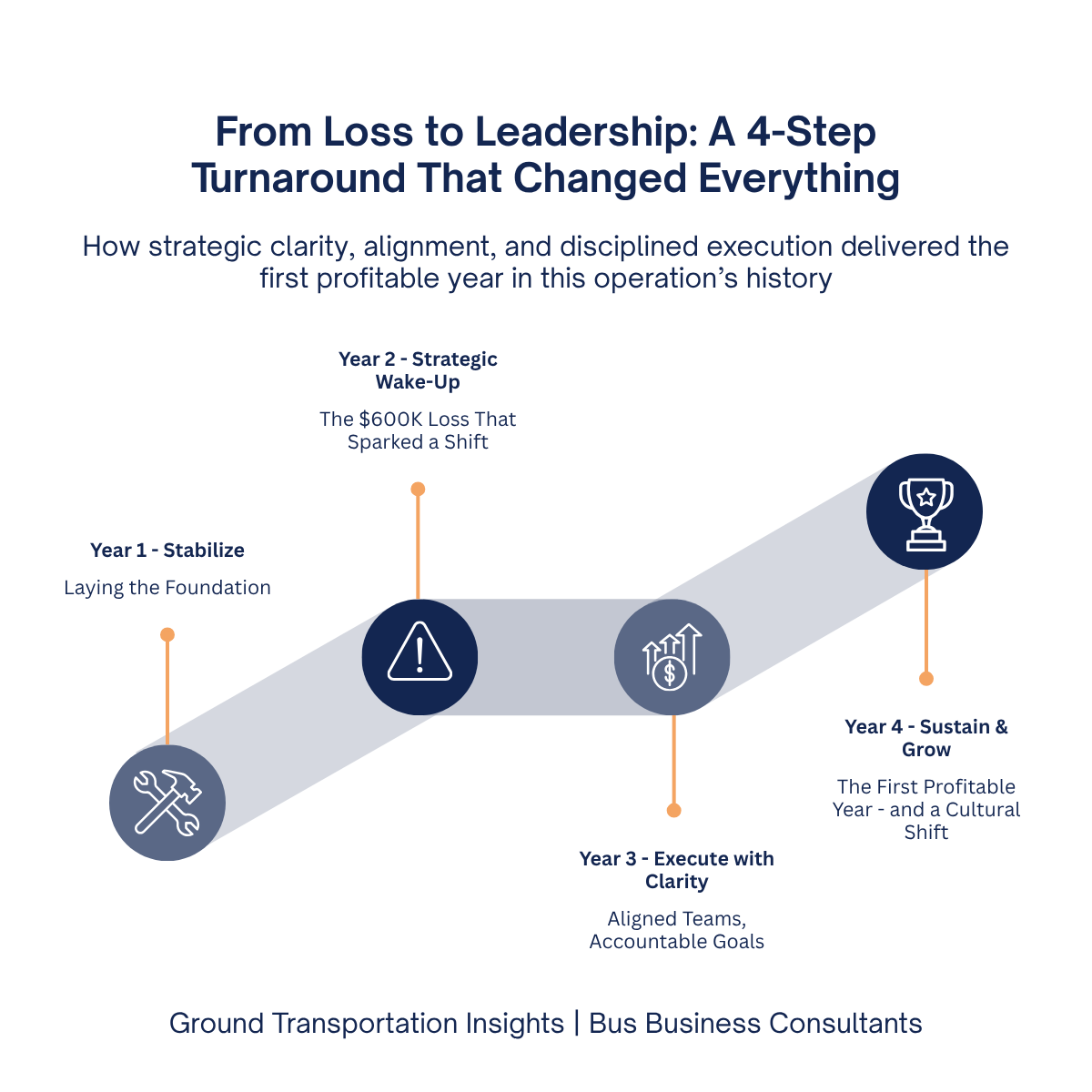When Strategy Becomes the Engine
A $2M turnaround rooted in clarity, alignment, and collective discipline

In a recent strategic planning webinar I facilitated with Busie, I shared an example from my time as VP & GM of American Coach Lines of Orlando — Coach America’s Central Florida operation. During that time, we experienced a dramatic shift — not just in top-line revenue, but also in how our entire organization aligned around a shared mission.
We grew annual revenues from $15 million to $22 million — a 47% increase — but the fundamental transformation wasn’t just financial. It was cultural. It was strategic. And it was sustained.
When I first stepped into the role, we were stabilizing the operation and getting our arms around the business. But in my second year, despite those early efforts, we posted a $600,000 net loss. It was a wake-up call — and the catalyst for real change. The following year, we turned that loss into a $1.4 million net profit — a $2 million swing and a 233% improvement in profitability.
Same team. Same market. Same challenges. But a completely different level of clarity, alignment, and execution.
That kind of shift doesn’t happen because of one person or one decision. It occurs when leadership, strategy, and frontline execution converge. It happens when a group of people rally around something bigger than themselves — a vision for what’s possible.
And it was more than just a strong year — this was the first time in the location’s history that it operated profitably. The business had been created through the integration of several acquired companies under Coach USA, and for years had carried the weight of legacy systems, cultural friction, and operational inefficiencies. The turnaround we achieved didn’t just change the numbers — it changed the trajectory.
Here’s how we did it — and how I now help others do the same.
Strategy That Lives in the Culture
We moved strategic planning out of the conference room and into the bloodstream of the business. It stopped being a once-a-year conversation and became a shared way of thinking, deciding, and acting.
Here’s the approach we used — one that continues to serve leaders and teams who are ready to align around what matters most:
1. Define the Mission, Sharpen the Focus, and Set Strategic Priorities
We began by getting clear on what we stood for — and where we were going. The vision and mission weren’t abstract statements. They became working tools, helping us evaluate decisions, filter opportunities, and stay focused on our true customers.
From there, we defined our strategic priorities — the key areas where we needed to focus our energy to make meaningful progress. These weren’t just broad themes like “growth” or “safety” — they were intentional choices based on where we believed we could create the most impact. Each priority served as a bridge between vision and execution, giving our team a clear sense of what matters most.
From those strategic priorities, we developed the objectives that ultimately drove the transformation — aligning our goals with purpose, capability, and opportunity.
We identified the segments we could best serve, and committed to pursuing them with excellence. We stopped spreading ourselves thin and instead channeled our energy where we could create the most value. That shared focus was energizing — and it gave the team confidence that we were moving in the right direction, together.
2. Set Goals That Inspire and Empower
We then translated strategy into meaningful, measurable goals. Using the SMART framework, we created objectives that not only tracked progress but also built ownership at every level.
Whether it was reducing customer complaints, improving maintenance KPIs, or lifting driver satisfaction scores, each goal had a purpose, an owner, and a timeline. The team didn’t just follow the strategy — they owned it.
3. Invest in What Matters Most
Alignment only works if the resources follow. We reviewed every dollar we spent and made intentional choices — investing in the tools, systems, and people that would allow us to grow smart.
We upgraded our technology, improved our fleet, and adjusted our spending to reflect our priorities. Waste went down. Confidence went up. Every investment was a vote of confidence in our future.
4. Build a Culture That Reflects the Plan
The strategy wasn’t just discussed at leadership meetings — it was embedded in conversations across departments. Teams understood why the goals mattered. Drivers, dispatchers, sales reps, mechanics — everyone had a line of sight to the mission.
That transparency built trust. It also sparked pride.
Wins were shared. Challenges were discussed openly. With each improvement, the team gained more momentum. Culture wasn’t just a byproduct of results — it became a driver of results.
Strategy as a Shared Operating System
That turnaround year at American Coach Lines didn’t just feel different — it functioned differently. It was the result of turning strategy into a shared system rather than a siloed task.
In my work today, I support operators and leadership teams in doing the same — turning ideas into alignment, and alignment into action. Whether it’s a growing company facing complexity, a legacy operator needing reinvention, or a high-potential team ready to step into something bigger, the principles still apply.
What changes is the culture around the plan — when the team owns the mission, the results multiply.
A Better Question for Leaders
If you’re leading a company right now — especially in transportation or service — ask yourself:
“Does our strategy live in our culture, or just on a slide deck?”
If it’s the latter, you’re not alone. Many organizations have good intentions and ambitious goals — but lack a clear rhythm to turn them into action.
The good news? That can change.

Brian Dickson is the owner of Bus Business Consultants and author of Ground Transportation Insights on Substack. Drawing on leadership roles in motorcoach operations and Disney’s Guest Transportation, he helps operators improve performance, culture, and growth—Bus Business Consultants: Driving Performance, Culture, & Growth in Ground Transportation.
This article was originally published on October 15, 2025 at Ground Transportation Insights.
The views expressed are those of the author alone and do not necessarily reflect the position of the American Bus Association.


